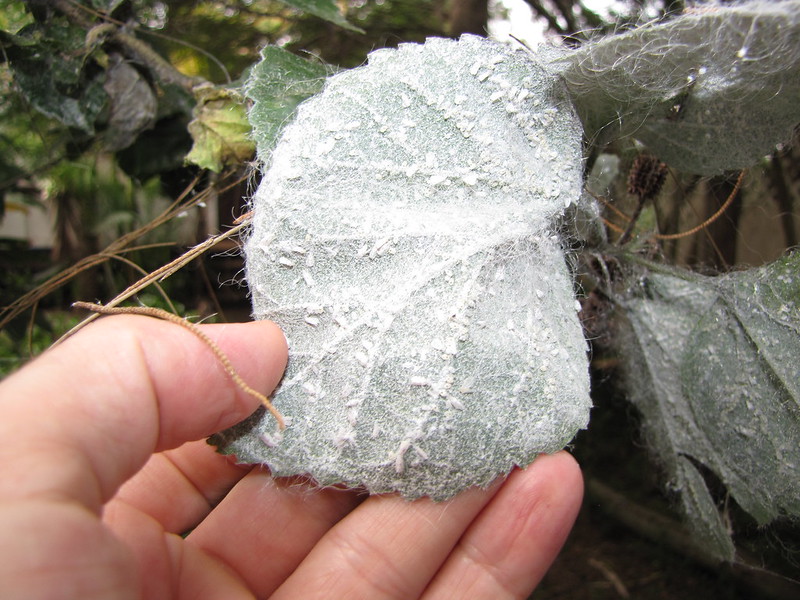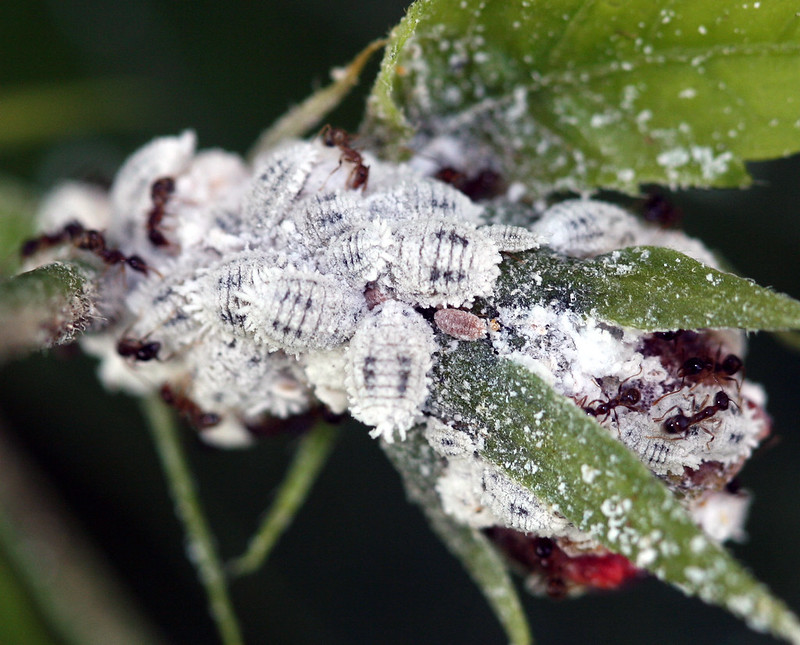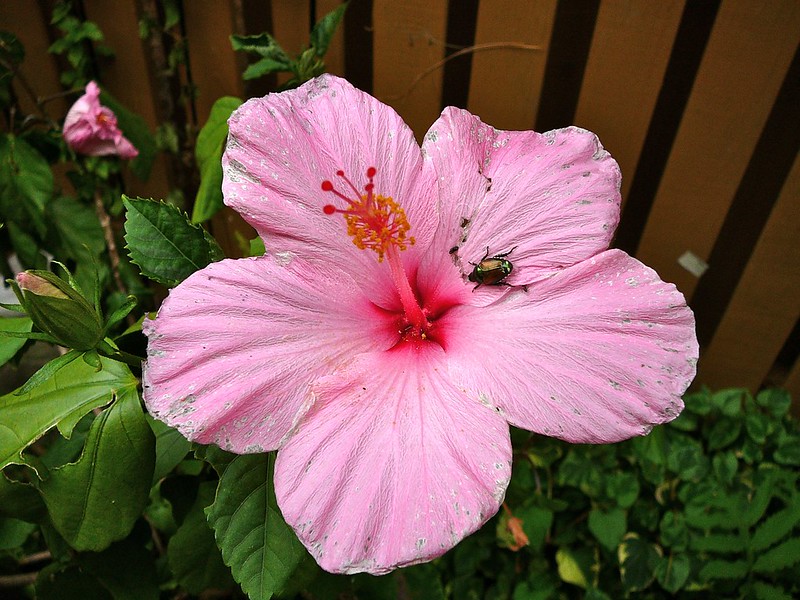Both hardy and tropical types of Hibiscus shrubs are prized for their spectacular display of flowers and showy foliage throughout the summer months. Although they are beautiful, they are susceptible to infestations from various common garden pests. Slugs, snails, mealybugs, aphids, root weevils, nematodes, and beetles are all very attracted to dining on various parts of Hibiscus, for both hardy and tropical types. Quick identification and treatment ensure that your Hibiscus is more likely to recover and continue to thrive.
Common Hibiscus Pests
Giant Whitefly
Aleurodicus dugesii, commonly known as the Giant Whitefly, is a sap-sucking insect that is commonly found on plants in the warmer USDA zones of 8-11. This pest measures 3/16 of an inch in length and is a very aggressive enemy of many different ornamental plants, ranging from Hibiscus to Begonias and some produce trees such as avocados and bananas. The Giant Whitefly deposits a waxy discharge as it feeds on the undersides of leaves. The eggs are laid in this waxy residue and in heavy outbreaks, there will be eggs laid on both the top and bottom of the leaves. Adults feed in groups and often stay on the same plant that they hatched on. Many generations of eggs are laid during a growing season. Left untreated, the Whitefly excretes a large amount of honeydew, which causes a secondary infestation of both ants and black mold.

Photo by Forest and Kim Starr, unedited, Flickr, Copyright Creative Commons 2.0
Treating Giant Whitefly on Hibiscus
The Giant Whitefly prefers to feed in large groups, which makes the option of pruning out infected stems and leaves easy while infestations are small. Remove and dispose of all plant material. Biological controls such as encouraging lady beetles, green lacewings, and syrphid flies are helpful but will not completely eradicate the whitefly. Spraying the underside of leaves with a strong stream of water dislodges the waxy residue while drowning the whitefly. A weekly spray of water is as effective as a scheduled spraying with insecticidal soaps or neem oil.
Preventing Giant Whitefly on Hibiscus
Make sure to plant Hibiscus in areas with full sun. Giant Whitefly prefers shadier and cooler locations that also stay moist longer. Using high nitrogen fertilizers will weaken the plant by forcing dense foliage growth, allowing the Whitefly to move in with no resistance from the Hibiscus. Practice good garden hygiene and keep the soil around the plants clear to discourage whitefly overwintering or egg laying. Encourage a healthy balance between pests and beneficial predators in your garden by not spraying broad-spectrum pesticides.
Melon Aphids
Melon Aphid, Aphis gossypii, mostly occurs in warm regions of the United States such as in the southern or western states. The adults are dark brown or black and are very active in warm weather. Unlike other types of aphids, the Melon Aphid will continue to feed and lay eggs even during high-heat periods. Eggs are laid on the undersides of the leaves, with a new generation laid as quickly as every seven days. The favored host plant for these aphids is the catalpa tree or rose of sharon shrubs. The aphids suck sap from all parts of the plant, which weakens the plant to the point that it loses the ability to photosynthesize efficiently. Melon Aphids are also vectors for viruses, especially on cucumbers and melons.
Treating Melon Aphids on Hibiscus
Parasitic wasps, lady beetles, and hover flies are natural predators and will keep outbreaks under control. Using insecticides such as broad-spectrum formulations are rarely useful in eradicating the aphid. Melon Aphid has a high resistance to most chemicals on the market for home gardeners. Using a strong stream of water from a hose to dislodge aphids from the plant is the least toxic method. Repeat this every week until control or eradication is complete.
Prune out any flower buds, branches, or leaves that have been disfigured by the aphids. This keeps the overall growth of the shrub healthy.
Preventing Melon Aphids on Hibiscus
Healthy plants are better able to withstand attacks from pests. Maintain proper watering to keep the shrubs from withering or being overwatered. Even though Hibiscus can be easily revived if under-watered, the plant can become weak if this occurs often. Do not overfertilize the plants with high-nitrogen formulations. Excessive foliage growth that is not fully supported by the root system makes for a weak plant that attracts pests and diseases. Sap-sucking insects such as aphids prefer a cool shady spot. Hibiscus requires a full sun location to grow at its best.
Black Scale
Black Scale, Saissetia oleae, is a sap-sucking insect that is also parthenogenic. This means that the female of the species can reproduce without the presence of male insects. The dark brown or black adult scale is one-eighth of an inch long and typically produces one to two generations a year. The scale produces a thick secretion called honeydew that can lead to secondary infections. Sooty mold collects on the honeydew, often causing the host plant to stop photosynthesizing properly. Ants will also move in at the honeydew stage. The ants harvest the honeydew and become protective of the scale insects, guarding them from beneficial predators. When infestation is very heavy, a previously vigorous plant will rapidly decline and eventually die. Quick diagnosis and treatment will ensure that your Hibiscus recovers.
Treating Black Scale on Hibiscus
Cultural and biological control of the Black Scale are most successful for home gardeners. Broad-spectrum insecticides should not be used, because they will kill both pests and beneficial insects such as lady beetles, parasitic wasps, and honeybees. Pruning out affected stems and foliage is the most effective method of Black Scale removal. Prune with the aim of opening up the canopy of the shrub so that more sun and heat reaches the inside growth. Black Scale does not reproduce during periods of high heat or in bright sunlight. Clean any honeydew or sooty mold off the plants with a steam of water when possible. Hibiscus will recover quickly from light to moderate infestations. Heavily infested plants may always remain unhealthy and should be disposed of in the trash or burned. Do not compost any infested plant parts.
Preventing Black Scale on Hibiscus
Grow your Hibiscus shrub in full sun with well-draining soil. Waterlogged plants in the shade will be stressed and more susceptible to Black Scale attack. Avoid over-fertilizing plants to encourage blooming. High nitrogen will cause dense, but weak, foliage growth that vulnerable to insect pests.
Pink Hibiscus Mealybugs
Mealybugs are wingless insects that form large colonies on plants. They exude a cottony-looking, waxy material that protects the insect as it slowly moves around a plant. Pink Hibiscus Mealybugs, Maconellicoccus hirsutus, is indeed pink, although that is obscured by their white protective coating. Pink Hibiscus Mealybugs attack a wide range of ornamental and edible plants and are most commonly found in the warmer growing zones of 8-11. Affected plants will not only have a mass of white material in the leaf joints and along stems, but may also have a sticky covering of honeydew on plant parts. Mealybugs are sap suckers and eventually reduce the vigor of plants and cause the deformation of new leaves and flowers.

Photo by Cory Campora, unedited, Flickr, Copyright Creative Commons 2.0
Treating Pink Hibiscus Mealybugs on Hibiscus
Parasitoid wasps are the best biological control against Mealybugs. They are able to attack through the white cotton covering the insects. Maintaining a hospitable environment for beneficial insects is the only way to encourage parasitoid wasps to live in your garden. These wasps love umbrella-shaped flowers such as fennel, yarrow, Queen Anne’s lace, and even carrots and parsnips. Insecticidal soaps can be used on ornamental shrubs such as hibiscus. Follow the manufacturer's recommendations exactly, and only use chemicals, even those organically approved, on calm days with no wind. Apply the spray either early in the morning or late in the afternoon so there is less risk of spraying beneficial insects.
Preventing Pink Hibiscus Mealybugs on Hibiscus
Maintaining good garden hygiene in areas where Pink HIbiscus Mealybug is common will help prevent this pest. Remove any fallen leaves or spent flowers to reduce areas that the Mealybug can hide during periods of hot weather or can overwinter. Prune out infected branches promptly and dispose of them in the trash or burn them if it is legal in your community.
Hibiscus Bud Weevil
Hibiscus Bud Weevil, Anthonomus testaceo squamosus, is a pest that is most likely to attack in the South, primarily in Texas across to Florida. This beetle feeds and lays its eggs in the flowers of Hibiscus, both tropical types and hardy shrubs. The flowers become disfigured and fall off before ever opening. Heavy infestations can cause the loss of flowers for a whole season. The adult weevil is one-eighth of an inch long with a tan body and a darker brown beak that is the same length or longer. Adults are usually found on the undersides of leaves, looking for soon-to-develop flower buds. The young weevil is always found deep inside the flowers near the base of the stem.
Treating Hibiscus Bud Weevil
Broad-spectrum insecticides should not be used on Bud Weevils. Any formulation containing malathion should not be used on the Hibiscus plant as it will damage the leaves and flowers. Spraying the plant with a solution of Bt, Bacillus thuringiensis, may help protect non-affected flowers and combat the weevils. This is a bacterial insecticide that targets very specific pests and is not harmful to humans, pets, or fish. Damaged flower buds and branches need to be removed from the plant and disposed of in the trash or burned. Damaged plants will quickly recover, even when damage is late in the growing season. Always water plants well before applying any chemical treatment to reduce the chance of stressing the plant further.
Preventing Hibiscus Bud Weevil
Clean up spent flowers and leaves often. Do not dispose of any infested plant material in a home or community compost. Hibiscus that are kept well watered and lightly fertilized with a balanced formula can withstand mild attacks from most pests. Over-fertilizing causes dense, weak growth on Hibiscus. Avoid using fertilizers high in nitrogen. Hibiscus needs at least 6 hours of full sun to bloom well and should be moved if it is growing in heavy shade.
Japanese Beetles
Japanese Beetles, Popillia japonica, are an invasive species of pest that is thought to have arrived in the United States in 1916. The mesmerizing metallic green and copper beetles are a type of scarab beetle native to parts of Asia where natural predators keep them in check. Japanese beetles in the United States and Europe have no natural predators and can wreak havoc on a garden during their adult stage. In late July, young grubs pupate into adults that eat and lay eggs for the next 40 days. The adults lay eggs in any open turfed areas, such as well-manicured lawns shorter than 2 inches. When the adults have completed their task of laying eggs, they die off, and the grubs hatch and survive over the winter months, happily chewing on the roots of grass. They will pupate into adults the following summer.

Photo by F Delventhal, unedited, Flickr, Copyright Creative Commons 2.0
Grass that has an infestation of Japanese beetle grubs turns brown and appears to need watering or fertilizing. It is easily pulled up (or even rolled back like a rug!) due to the lack of a root system. Hibiscus unfortunately are a favorite of the adult beetles and can be defoliated in a matter of days if not protected. Skeletonized foliage and partially eaten flowers during the months of July and August are the telltale signs that the adults have hatched.
Treating Japanese Beetles on Hibiscus
Japanese Beetles have no natural predators in the United States and are more prevalent in 70% of the United States. The western states of Washington, Idaho, Montana, Oregon, California, Utah, Colorado, Nevada, and Arizona are protected by a USDA quarantine restricting the transport of plant material from other states; this has reduced the spread of this invasive species.
Hibiscus can sustain heavy damage if the plant was healthy before the outbreak. Continue to water the plants as normal and do not be tempted to over-fertilize to regrow foliage quickly. If you have Hibiscus in a container or planter, covering the plants as Japanese Beetle season starts will help keep damage to a minimum and can be removed once the adults have died back. Use lightweight horticultural fabric or old mesh window screening so that the plant still receives plenty of light. Plants that are in the garden or too large to cover may be protected with a repellent spray or using the pheromone traps marketed to trap the adults. Place the traps as far away from the plants you want to protect because they do a very good job of attracting the beetles. Empty or replace the traps as often as possible.
Preventing Japanese Beetles on Hibiscus
The best prevention against Japanese beetles is to target the grubs in your lawn. The lawn treatment milky spore is a bacteria that only affects the Japanese beetle grub and is not harmful to humans or wildlife. The bacteria kill off the grubs before they can pupate into adults, but it must be used at a very specific time. The grubs will tunnel deeper into the ground as the temperatures fall in the autumn. Milky spore needs to be applied after the grubs hatch and while temperatures are still above 50 degrees F. Follow the manufacturer's instructions exactly and there will be a reduction in the amount of adults hatched from your lawn. Complete eradication may never be attainable because the Japanese beetle is able to fly to its next meal. Milky spore survives in the soil for up to 10 years.
Root Knot Nematodes
Root knot nematodes, Meloidogyne incognita, are microscopic pests that live in the soil and typically attack a wide variety of produce. They also attack ornamental plants such as Hibiscus, both tropical and hardy types. Plants that are affected will have yellowing foliage that is droopy, making the plant look like it has been over or underwatered. Reduced overall growth and smaller flower size are also clues to an attack by these nematodes. Closer inspection of the roots will show white balls or knots growing on the roots. The nematodes hatch in the soil and feed on the ends of the roots during warm summer months. The galls are where the nematode has destroyed the root tissue, preventing the plant from taking up moisture and nutrients as normal. Over time the whole plant will ‘starve’ and die.
Treating Root Knot Nematodes on Hibiscus
Controlling nematodes in the home garden can be a very difficult task. There are no chemical treatments authorized for use in a home garden, making prevention by mechanical and cultural means the only viable option. Sandy soils are more likely to house root knot nematodes, so amending soils with organic compost or other peat-free products to boost the texture and water-holding capacity of the soil will help to deter the nematodes.
Preventing Root Knot Nematodes on Hibiscus
Nematodes are often introduced to an area by bringing in infected plant material or using tools in more than one garden without properly sanitizing them in between. Inspect plants very carefully when exchanging divisions or purchasing from plant sales. Sanitize pruners, spades, hori horis, and any other tool that digs in the soil after use. Keep Hibiscus plants in full sun and water them well to prevent any type of stress from repeated dehydration. In areas where root knot nematodes are common, buy cultivars and varieties of Hibiscus that are rated for nematode resistance.
Hibiscus Pests Chart
|
Pest |
Identifying |
Treating |
|
Giant Whitefly |
Sap-sucking insect found in warmer zones, often leaving a waxy discharge and honeydew |
Prune infected stems, encourage beneficial insects, and spray leaves with water or insecticidal soaps weekly |
|
Melon Aphids |
Sapsucking dark brown or black insects that thrive in warm regions, laying eggs even in high heat |
Encourage natural predators, use a strong stream of water to dislodge pests, and prune disfigured parts |
|
Black Scale |
Dark brown or black, one-eighth inch long sap-sucking insect that produces honeydew, leading to sooty mold and ant infestations |
Prune infested parts, avoid broad-spectrum insecticides, and clean honeydew with a steam of water |
|
Pink Hibiscus Mealybugs |
Wingless insects that form cottony, white colonies on plants, exuding honeydew and reducing plant vigor |
Encourage parasitoid wasps and use insecticidal soaps as recommended, apply sprays in calm weather and during early morning or late afternoon |
|
Japanese Beetles |
Metallic green and copper beetles that damage plants and lawns, with skeletonized foliage indicating their presence |
Cover plants with lightweight fabric, use repellent sprays, and place pheromone traps away from desired plants |
|
Root Knot Nematodes |
Microscopic pests causing yellow, droopy foliage and white knots on roots, leading to reduced plant growth and eventual death |
Amend soil with organic compost to improve texture and water-holding capacity |
Sources: "Hibiscus—Hibiscus spp." Agriculture and Natural Resources, University of California. ipm.ucanr.edu
 |
Author Robbin Small - Published 5-12-2023 |
